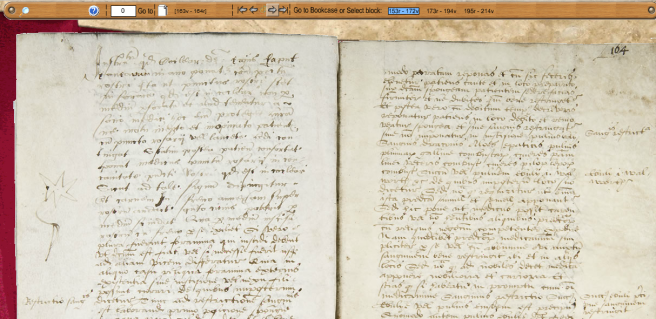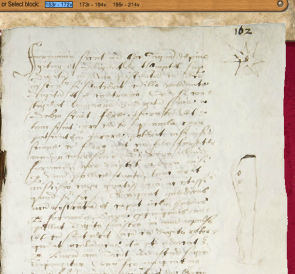This isn’t the big blogpost I’ve been meaning to put up for ages: instead it’s something I would have posted to the forum normally, but since the forum’s had a few hiccups lately I’ll just make a quick post to share it here.
I found the marginalia in this MS quite similar to the marginal stars in the Voynich manuscript’s Quire 20. I don’t know if the star-with-a-tail in the margin of manuscripts is a common occurrence in medieval medical/pharma books, but I’ve never come across such an example before outside of the Voynich “recipe” section:

The MS is a collection of medical recipes, and this particular section is a copy of Arderne’s Practica Chirurgiae. It is slightly too late for the Voynich, although very little is known (England, 16thC, with many later additions), as the various hands who composed and annotated the text are anonymous. A detailed description of Ms. Hunter 135 is available on the Glasgow library’s website.


Are the stars drawn by the original scribes or added by a later owner? Of course I can’t help but wonder if these stars refer to something in the text here or if they are a kind of decorative highlight for a special section of text, especially the first one with its tail.
Apparently this version of Arderne’s work is a much less ornate copy of another Glasgow MS: Hunter 251, which I unfortunately haven’t been able to find fully digitized yet, so I cannot check if there are marginal stars in the other one too.
Are marginal stars with tails present elsewhere? Personally these are the first I’ve found. Let me know in the comments!
Update: I found another, earlier MS from this collection (the Malaga Corpus) Hunter Ms. 185, which is also worth mentioning here: although it is devoid of stars, it does feature a list of recipes, each with a marginal squiggle which brings to mind the Voynich star tails. The initial f’s also form an almost gallows-like shape. Two examples:


The tailed star is great! I couldn’t find a link to the complete scan of the ms, could you please share it? I will comment more extensively in a few days.
LikeLike
Hi,
glad you liked the tailed star… I was quite surprised to find it!
To view the complete MS is a bit of a process but well worth it:
click the link to the Malaga Corpus in my post. It will take you to a list of all the manuscripts in the corpus. At the top right of that page, click “register”, and then fill in the form to register (free): you will then be able to view complete scans of all the MS’s on the list (just select the book you want to view from the library).
The site is really fantastic and for many manuscripts there are transcriptions and translations of the text available too. Unfortunately, for Hunter 135, there is no transcription available with the scans.
LikeLiked by 1 person
Hi Vviews,
the text corresponding to the third (?) illustration in ms Hunter 135, f158v is transcribed and translated here (p.319 – footnote 69):
https://books.google.com/books?id=nYQeixG4zrQC&pg=PA319
All the three images are referenced in the text by the expression “signum depingitur” (a figure is painted) so they are an integral part of the manuscript. The “phi” illustration could then represent “a hole in one of the buttocks”?
I think the star could represent a flowering plant mentioned in one of the recipes (see below).
I cannot understand enough of the text to say anything about the crescent (but it seems that the Latin text contained a chapter about the Moon and its influence on surgery and phlebotomy).
Similar figures appear in Sloane 56 f44
https://www.bl.uk/catalogues/illuminatedmanuscripts/ILLUMIN.ASP?Size=mid&IllID=6560
In my opinion, f59v
http://www.bl.uk/catalogues/illuminatedmanuscripts/ILLUMIN.ASP?Size=mid&IllID=6572
provides an explanation for the “tailed star” in Hunter 135 163v: it represents the rose mentioned when discussing “oleum rosarum” (oil of roses) for treating the wound after surgery.
Sloane 76 f47v
http://www.bl.uk/catalogues/illuminatedmanuscripts/ILLUMIN.ASP?Size=mid&IllID=6551
seems to parallel the third illustration you posted (f162r). Also in this case, the flower seems to illustrate the use of “oyle of roses” (end of 7th line).
LikeLiked by 1 person